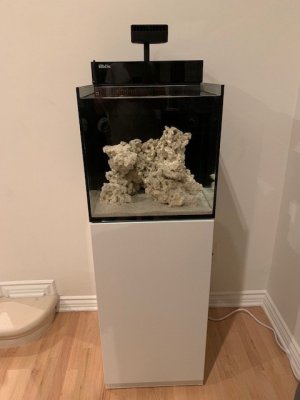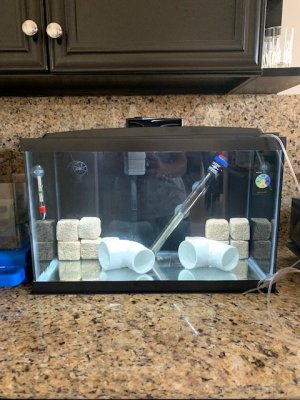- Joined
- Oct 10, 2019
- Messages
- 13
- Reaction score
- 31
I've seen similar threads out there but I just wanted to be sure I'm up to date with current best practice recommendations for quarantine with an emphasis on clownfish. I'll provide some background info first.
My DT is a RedSea Max Nano that has been cycling for the past 25 days, containing 20-25lb of aquascaped reef saver dry rock and 10lb of caribsea arag-alive fiji pink live sand as well as about a dozen marinepure 2 inch bio blocks in the sump under the protein skimmer. The cycle is going fairly well, have used a couple bottles of Dr Tims one and only and have been dosing their ammonium chloride. So far I think the nitrobacter and other colonies have been slower to multiply, as I have nearly 0 ammonia 24h after dosing 2ppm AC but my nitrites still read in the 2-5 range. Have been dosing every few days when both ammonia and nitrite levels drop below 0.2 per Dr Tims website instructions. No livestock in the DT yet.
My QT is a 10g aqueon LED kit that I got at Petco including a HOB filter (switched out the stock charcoal for filter floss), 100W heater, koralia nano powerhead, PVC and 10 blocks of the marinepure that I took from my DT after a few weeks. Also added a bottle of biospira.
I'm planning on adding two juvenile designer clowns later today from my LFS. They seem like a reputable dealer but I understand that doing a full quarantine on my own would be best practice.
My main question is, what are some of the current medications regimens people recommend for prophylactic dosing? Is the order of medications important (e.g. always do copper last)? Which medications out there can be combined with copper, and is it wise to do so in the setting of prophylaxis where no disease is suspected and time is not a factor?
I understand that some consider chloroquine "gold standard" but I am concerned about the absorptive capabilities of the marinepure blocks and the inability to measure levels of chloroquine after dosing. Getting pure chloroquine would not be difficult for me, but I got myself a Hanna checker for copper and was wanting to try my hand at copper dosing for two weeks at some point during QT. I also have prazipro, API general cure and metroplex on hand. Obviously it would be ideal to use a regimen that has as few medications and steps as possible.
Any help or tips would be much appreciated!!


My DT is a RedSea Max Nano that has been cycling for the past 25 days, containing 20-25lb of aquascaped reef saver dry rock and 10lb of caribsea arag-alive fiji pink live sand as well as about a dozen marinepure 2 inch bio blocks in the sump under the protein skimmer. The cycle is going fairly well, have used a couple bottles of Dr Tims one and only and have been dosing their ammonium chloride. So far I think the nitrobacter and other colonies have been slower to multiply, as I have nearly 0 ammonia 24h after dosing 2ppm AC but my nitrites still read in the 2-5 range. Have been dosing every few days when both ammonia and nitrite levels drop below 0.2 per Dr Tims website instructions. No livestock in the DT yet.
My QT is a 10g aqueon LED kit that I got at Petco including a HOB filter (switched out the stock charcoal for filter floss), 100W heater, koralia nano powerhead, PVC and 10 blocks of the marinepure that I took from my DT after a few weeks. Also added a bottle of biospira.
I'm planning on adding two juvenile designer clowns later today from my LFS. They seem like a reputable dealer but I understand that doing a full quarantine on my own would be best practice.
My main question is, what are some of the current medications regimens people recommend for prophylactic dosing? Is the order of medications important (e.g. always do copper last)? Which medications out there can be combined with copper, and is it wise to do so in the setting of prophylaxis where no disease is suspected and time is not a factor?
I understand that some consider chloroquine "gold standard" but I am concerned about the absorptive capabilities of the marinepure blocks and the inability to measure levels of chloroquine after dosing. Getting pure chloroquine would not be difficult for me, but I got myself a Hanna checker for copper and was wanting to try my hand at copper dosing for two weeks at some point during QT. I also have prazipro, API general cure and metroplex on hand. Obviously it would be ideal to use a regimen that has as few medications and steps as possible.
Any help or tips would be much appreciated!!
















